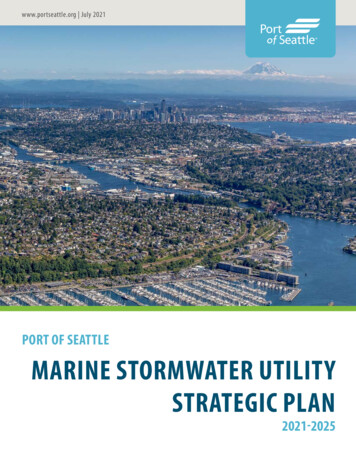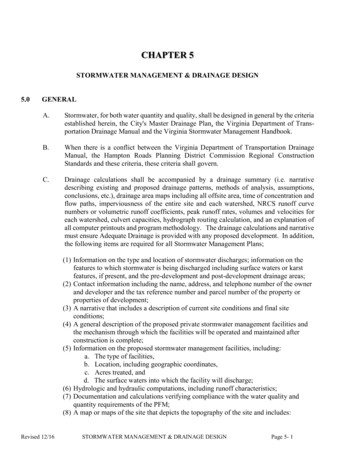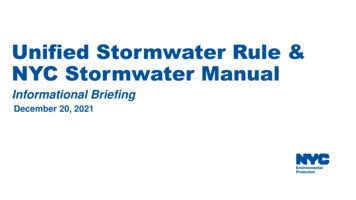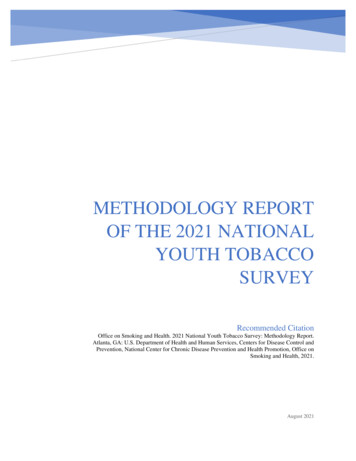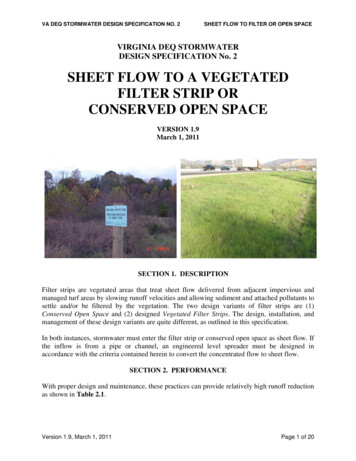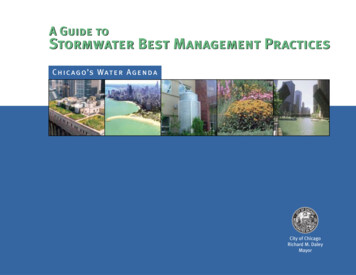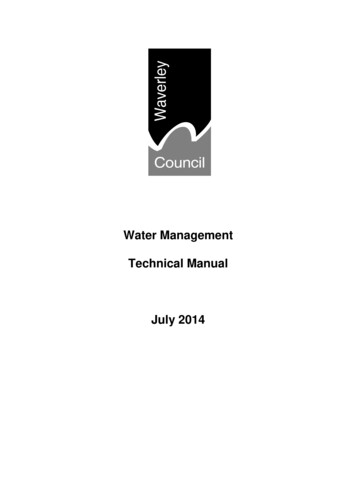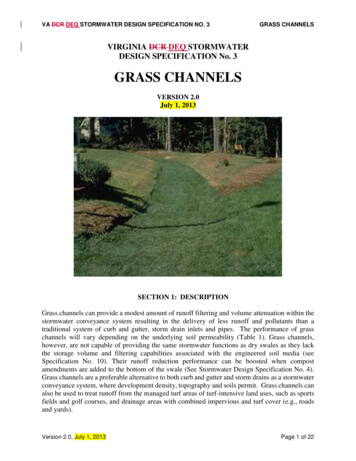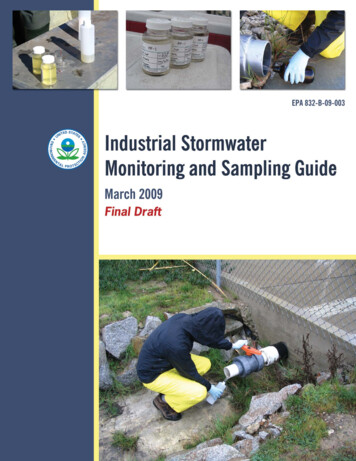
Transcription
Industrial Stormwater Monitoring and Sampling GuideAcknowledgementsAll photos are courtesy of Tetra Tech, Inc. Sampling illustrations in Section 2 are courtesy of WashingtonDepartment of Ecology’s guide on How To Do Stormwater Sampling: A guide for industrial facilities(available at http://www.ecy.wa.gov/pubs/0210071.pdf)Final DraftPrepublication CopyA formatted version of this guide will be available in April, 2009.
Industrial Stormwater Monitoring and Sampling GuideIndustrial Stormwater Monitoring and Sampling Guide1. Introduction to Stormwater Monitoring and Sampling2. Preparation for Monitoring2.1 Determine Where Stormwater Is Discharged From Your Property2.2 Determine Where You Will Collect Samples2.3 Determine Which Types of Monitoring Requirements Apply At Each Outfall2.4 Determine if Your Facility is Subject to Impaired Waters Monitoring Requirements2.5 What Type of Storm Events Qualify for Monitoring2.6 Select the Monitoring Team2.7 Select a Laboratory to Analyze the Samples2.8 Document Monitoring Procedures in Your SWPPP3. Conduct Monitoring3.1 What to Have In Place Prior to Collecting Stormwater Samples3.2 Collect Stormwater Samples3.3 Record Information for Each Monitoring Event3.4 Quality Assurance Considerations3.5 Conducting Visual Assessments of Stormwater Discharges4. Evaluate Monitoring Results4.1 Evaluating Quarterly Visual Assessment Results4.2 Evaluating Benchmark Monitoring Results4.3 Effluent Limitation Guideline Monitoring Results4.4 Specific Pollutants and Control Measure Options5. Record‐Keeping and Reporting5.1 Reporting Monitoring Data6. Train Personnel7. ReferencesAppendix A – 2008 MSGP Industrial Stormwater Monitoring FormAppendix B – 2008 MSGP Visual Monitoring FormAppendix C – 2008 MSGP Industrial Stormwater Collection 434445
Industrial Stormwater Monitoring and Sampling GuideThe Industrial Stormwater Monitoring and Sampling Guide (“guide”) is a how‐to primer for industrialfacility operators on how to conduct visual and analytical monitoring of stormwater discharges. Thetarget audience is operators of facilities subject to the U.S. Environmental Protection Agency’s (EPA)2008 Multi‐Sector General Permit (2008 MSGP) or a similar State‐issued industrial stormwater permit.The information presented will also be useful to anyone interested in industrial stormwater monitoring.The procedures presented in this guide, specifically related to monitoring methodology and qualityassurance, will help ensure that stormwater samples yield usable information.The 2008 MSGP covers specific industrial activities (see Appendix D of the 2008 MSGP, available atwww.epa.gov/npdes/msgp) in States, territories, and Indian Country lands where EPA is the National PollutantDischarge Elimination System (NPDES) permitting authority (i.e., in those States or territories not authorized toissue NPDES permits themselves – see Appendix C of the 2008 MSGP).This guide does not impose any new legally binding requirements on EPA, States, or the regulatedcommunity, and does not confer legal rights or impose legal obligations upon any member of the public.In the event of a conflict between the discussion in this document and any statute, regulation, or permit,this document would not be controlling.Monitoring vs. Sampling. In this guide, “sampling” refers to the actual, physical collection and analysis ofstormwater samples. The term “monitoring” refers to both sampling and visual observations of stormwaterdischarges, including the related preparation and documentation tasks.Interested parties are free to raise questions and objections about the substance of this guide and theappropriateness of the application of this guide to a particular situation. EPA and other decision makersretain the discretion to adopt approaches on a case‐by‐case basis that differ from those described in thisguide where appropriate.1. Introduction to Stormwater Monitoring and SamplingMost industrial stormwater permits require installation and implementation of control measures tominimize or eliminate pollutants in stormwater runoff from your facility. The control measures youchoose for your facility must be documented in your facility‐specific Stormwater Pollution PreventionPlan (SWPPP). The results of your stormwater monitoring will help you determine the effectiveness ofyour control measures, and overall stormwater management program. Evaluation of your stormwatermanagement program will include inspections, visual assessments, and monitoring (i.e., sampling) ofspecified stormwater discharges. Regular stormwater inspections and visual assessments providequalitative information on whether there are unaddressed potential pollutant sources at your site, andwhether existing control measures are effective or need to be reevaluated. Stormwater samplingprovides quantitative (i.e., numeric) data to determine pollutant concentrations in runoff and, in turn,the degree to which your control measures are effectively minimizing contact between stormwater andpollutant sources, and the success of your stormwater control approach in meeting applicable dischargerequirements or effluent limits.The following are the types of industrial stormwater monitoring requirements typically included inindustrial general permits:1
Industrial Stormwater Monitoring and Sampling Guide Visual Assessments of Discharges. Permittees are required to regularly and frequently (e.g.,quarterly under the 2008 MSGP) take a grab sample during a rain event and assess key visualindicators of stormwater pollution – color, odor, clarity, floating solids, settled solids, suspendedsolids, foam, oil sheen, and other qualitative markers of pollution. The findings of theseassessments are used to trigger further facility inspections and corrective actions to modifyproblems found at the site. Indicator or Benchmark Sampling. Stormwater samples are collected from a site’s dischargepoints (or outfalls) for laboratory analysis and the results are compared with benchmarkpollutant concentrations as an indicator of the performance of stormwater control measures. Abenchmark pollutant concentration is a level above which a stormwater discharge couldadversely affect receiving water quality (and control measures must be evaluated) and, if below,the facility is not expected to have an impact on receiving water quality. This type of monitoringdiffers from “compliance monitoring” (see below) in that exceedances of the indicator orbenchmark levels are not considered violations, but rather “red flags” that could point to aproblem at the site with exposed pollutant sources or control measures that are not workingcorrectly. For instance, the 2008 MSGP includes “benchmarks” that are based to a large degreeon EPA’s aquatic life criteria. Where the average of samples taken over four consecutivequarters exceed the applicable benchmark concentration of a particular pollutant, the permitteeis required to investigate whether the higher pollutant levels can be attributed to somepollutant source or faulty control measure(s), and to address such problems through correctiveaction and possibly further monitoring. Compliance Sampling. Where a facility is subject to one of the Federal effluent limitationguidelines (ELGs) addressing limits on stormwater runoff, sampling is required to determinecompliance with those limits. Table 1 provides a list of the current applicable effluent limitationguidelines.Table 1. Applicable Effluent Limitations Guidelines(2008 MSGP Part 2.1.3)Regulated Activity40 CFR Part/SubpartDischarges resulting from spray down or intentional wettingPart 429, Subpart Iof logs at wet deck storage areasPart 418, Subpart ARunoff from phosphate fertilizer manufacturing facilities thatcomes into contact with any raw materials, finished product,by‐products or waste products (SIC 2874)Runoff from asphalt emulsion facilitiesPart 443, Subpart ARunoff from material storage piles at cement manufacturingPart 411, Subpart CfacilitiesMine dewatering discharges at crushed stone, constructionPart 436, Subparts B, C, or Dsand and gravel, or industrial sand mining facilitiesRunoff from hazardous waste landfillsPart 445, Subpart ARunoff from non‐hazardous waste landfillsPart 445, Subpart BRunoff from coal storage piles at steam electric generatingPart 423facilities2
Industrial Stormwater Monitoring and Sampling GuideThese limits are required to be included in all general industrial permits. Typically, permitsrequire corrective action and further sampling when an effluent limitation is exceeded. Anexceedance of an applicable effluent limitation guideline constitutes a violation of the permit. Monitoring Requirements for Discharges to Impaired Waters ‐ General industrial permits mayhave special monitoring requirements for facilities that discharge pollutants of concern intoimpaired waters.For an explanation of these monitoring requirements in the 2008 MSGP see Part 6.2. Part 8 of the 2008 MSGPincludes the benchmark and effluent limitation guideline monitoring requirements for each of the industrialsectors affected by such requirements.2. Preparation for MonitoringThis section describes the information you will need before monitoring. While this guide is meant to bea general primer for anyone interested in industrial stormwater monitoring, Section 2 follows theorganization of the 2008 MSGP. Many State general permits are very similar to the 2008 MSGP. It isEPA’s hope that this format will be of use to permittees in most states. However, if you are subject to aState industrial general permit, you should compare your permit’s monitoring requirements to therequirements reflected in this guide to ensure that you are following all applicable State requirements.In general, preparation is critical to make sure that industrial stormwater monitoring is conductedproperly and in a timely manner. Most of this information should have been collected previously for thepurposes of submitting your permit application or Notice of Intent (NOI), and in developing themonitoring procedures section of your stormwater pollution prevention plan (SWPPP). However, thisguide reviews some of the steps necessary to develop this information, such as the site map componentof the SWPPP, in case facilities have not already done so. If you have already completed any of thesesteps in this section, you can skip to the next application section or subsection in this guide. For moreinformation on how to develop a SWPPP, refer to EPA’s guide Developing Your Stormwater PollutionPrevention Plan: A Guide for Industrial Operators, available on EPA’s website atwww.epa.gov/npdes/stormwater/msgp.If you have already submitted your NOI, the following documents will serve as good resources forinformation that you will need prior to monitoring: A copy of your NOI or application submitted to EPA or a State, and your assigned permitregistration number. A copy of the EPA/State response to your NOI/permit application submission if it includesspecific details pertaining to your monitoring (e.g., pollutants required to be monitored,frequency of monitoring, benchmark or compliance sampling requirements, etc.). A copy of your applicable permit, including the accompanying fact sheet. A complete copy of your SWPPP, which must include a detailed site map of your facility withlocations of all stormwater monitoring points, and a description of the procedures you or your3
Industrial Stormwater Monitoring and Sampling Guidestormwater pollution prevention team will follow when conducting monitoring and visualassessments.2.1 Determine Where Stormwater Is Discharged From Your PropertyIf you have not already done so, walk the grounds and perimeter of your facility during a storm event toidentify where runoff discharges from the site (known as “outfalls”). Outfalls are locations wherestormwater exits the facility property, including pipes, ditches, swales, and other structures thattransport stormwater. If possible, walk outside the boundary of your facility to identify outfalls that maynot be apparent from within your site.Stormwater discharges to the slot drain and is conveyed offsite through a valved pipe.You should note where: Concentrated stormwater exits your facility (e.g., through a pipe, ditch or similar conveyance).These outlets are usually good sampling points. Dispersed runoff (i.e. sheet flow) flows offsite (e.g., through a grassy area or across a parkinglot). Note whether concentrated flows commingle with the sheet flow. Storm drain inlets or catch basins are located. Try to determine where the storm drains sendyour runoff (e.g., to your municipal separate storm sewer system [MS4], to a combined sewersystem, to the separated sanitary sewer, or directly to a nearby waterbody).4
Industrial Stormwater Monitoring and Sampling Guide Authorized non‐stormwater discharges commingle with stormwater prior to discharge (suchcommingled discharges may be covered under your permit). Areas where stormwater might enter your facility from neighboring facilities and comminglewith your stormwater discharges.Terms to Know:Combined Sewer System: Combined sewer systems are sewers that are designed to collect rainwaterrunoff, domestic sewage, and industrial wastewater in the same pipe. Most of the time, combinedsewer systems transport all of their wastewater to a sewage treatment plant, where it is treated andthen discharged to a water body. During periods of heavy rainfall or snowmelt, however, thewastewater volume in a combined sewer system can exceed the capacity of the sewer system ortreatment plant. For this reason, combined sewer systems are designed to overflow occasionally anddischarge excess wastewater directly to nearby streams, rivers, or other water bodies.MS4: A conveyance or system of conveyances (including roads with drainage systems, municipal streets,catch basins, curbs, gutters, ditches, man‐made channels, or storm drains) which are owned andoperated by a public body (created by or pursuant to State law) having jurisdiction over disposal ofsewage, industrial wastes, stormwater, or other wastes that discharges to waters of the United States;designed or used for collecting or conveying stormwater; which is not a combined sewer; and which isnot part of a publicly owned treatment works (POTW). [40 CFR 122.26(b)(8)].Mark these locations on your facility site map, which will be included as part of your SWPPP, and labeleach outfall location with unique identifiers to differentiate them. For example, you may decide toname the different outfalls according to where the stormwater is being discharged, such as MS4‐1, MS4‐2, etc. for outfalls discharging to the MS4 or ST‐1, ST‐2, etc. for outfalls discharging directly to anadjacent stream. Using unique identifiers will help you to coordinate monitoring requirements.In addition to marking the outfalls on the map, you will need to determine the drainage area for eachdischarge point. If your facility is large and has significant changes in elevation, a topographic map maybe necessary. However, if your facility is small and relatively flat, the best way to define the drainagearea for each outfall is an on‐the‐ground visual assessment, preferably during a rain event. Sketch thebasic drainage areas on the map for each outfall. Knowing the drainage area for each outfall is helpfulwhen your sampling indicates problems at that outfall. You can focus your efforts on the industrialmaterials and activities in that drainage area, instead of the entire site, to identify what may be causingthe problem.2.2 Determine Where You Will Collect SamplesNow that you have determined the different points of discharge from your site, you will need to selectthe exact locations from which you will be collecting your stormwater samples. Note that Part 5.1.5.2 ofthe 2008 MSGP requires industrial operators to document in their SWPPPs the location where sampleswill be collected. Generally, industrial stormwater permits require that you sample stormwaterdischarges prior to the stormwater leaving your facility, and at a location downstream from all of yourindustrial materials and activities. The reason behind requiring such a location is so that the sample is5
Industrial Stormwater Monitoring and Sampling Guiderepresentative of your facility’s discharge, taking into account the types of pollutants that may becontained in runoff from the property.Appropriate sample locations include: Underground pipes that collect stormwater from drop inlets and convey stormwater to anoffsite location (e.g., street, curb or MS4). Be sure you collect only the stormwater dischargingfrom your facility and not the baseflow in the pipes that is being discharged from facilitiesupstream. Do not enter underground locations to collect samples. Use a pole with a samplingcontainer attached at the end to collect the sample. Open ditches, gutters or swales that carry stormwater from your facility to an offsite location. Ifthese conveyances contain runoff from another facility, it is important to note that in yourSWPPP; Facility driveways and other street access points; and6
Industrial Stormwater Monitoring and Sampling Guide Outlets discharging offsite from onsite stormwater detention ponds or other types of structuralcontrol measures. It is important to sample at the OUTLET of your structural control measures,as opposed to the INLET of such structures, in order to determine the quality of the water aftertreatment.Where to Sample When There Are Multiple Discharge PointsYou are required to monitor all outfalls that receive stormwater discharges from your industrial activity.See Part 6.1.1 of the 2008 MSGP. If you have multiple stormwater discharge points at your facility, youneed to identify which outfalls are associated with industrial materials and activities, and monitor thoseoutfalls. Understanding the hydrologic connection between your outfalls and the parts of your facilitythat drain to those points, and the pollutants associated with the industrial activities in these areas, willassist you in designing a monitoring program that is representative of the pollutants being dischargedfrom your site. Developing such an understanding will also help later on when you begin to assess yoursampling results and determine where improvements could be made to your stormwater controlmeasures. The site map you prepare (see Part 5.1.2 of the 2008 MSGP) will help you understand thecorrelation between your areas of potential pollutant sources, the direction of stormwater flow fromthose areas, and the discharge points.7
Industrial Stormwater Monitoring and Sampling GuideNote that you are not required to monitor at outfall locations that receive stormwater flow only fromunregulated areas of your site (i.e., there are no industrial materials or activities in the drainage area).For instance, a hypothetical facility may have two outfalls, one that receives discharges from an areawhere industrial materials are handled and stored, and a second outfall that receives discharges from anunregulated parking lot used by employees. In this scenario, the industrial permittee would only collectsamples from the first outfall because it discharges stormwater associated with industrial activity.Alternatively, if the site’s second outfall (e.g., the outfall receiving runoff from the parking lot) alsodrains areas of the facility with regulated industrial activities, then this outfall would also need to besampled. In this situation, sampling for this outfall should be done at a location prior to where the twoflows commingle so that you are capturing the industrial portion of the flow. See Part 6.1.2 of the 2008MSGP.Where to Sample if Outfalls Are Substantially IdenticalIf your facility has two or more outfalls whose discharges are “substantially identical,” some industrialstormwater permits, including the 2008 MSGP, allow you to monitor the discharge at just onerepresentative outfall and apply the results to the other substantially identical outfalls. EPA defines“substantially identical” in the 2008 MSGP as follows:“ two or more outfalls that you believe discharge substantially identical effluents, based on thesimilarities of the general industrial activities and control measures, exposed materials that maysignificantly contribute pollutants to stormwater, and runoff coefficients of their drainage areas .” See Part 6.1.1 of the 2008 MSGP.The flexibility provided to permittees to sample at just one location, which is considered representativeof all substantially identical outfalls, is an exception to the rule stated above that samples must be takenfrom all outfalls at a facility. Note that this exception does not apply to compliance monitoring (effluentlimitation guideline monitoring), which must be conducted at each outfall to which the effluentguideline applies.In choosing which of the substantially identical outfalls from which to sample, you should select theoutfall that has been observed to have the most consistent flow. To use the substantially identicaloutfall exception, you must document in your SWPPP how the two or more outfalls are substantiallyidentical, based on the above definition. You will need to document the following information: The locations of the outfalls;Estimated size of the drainage area (in square feet) for each outfall;General industrial activities conducted in the drainage area of each outfall;Control measures being implemented in the drainage area of each outfall;Why the outfalls are expected to discharge similar stormwater; andAn estimate of the runoff coefficient of the drainage areas (0.0 no runoff potential to 1.0 allprecipitation runs off).The runoff coefficient is the ratio of excess runoff to the amount of precipitation for a given time over agiven area, with a 0 (zero) runoff coefficient meaning no runoff potential and 1.0 (one) meaning acompletely impervious surface and all stormwater runs off. The runoff coefficient is related to theamount of impervious surfaces (buildings, pavement, sidewalks, etc.) versus pervious surfaces (grass,8
Industrial Stormwater Monitoring and Sampling Guidegraveled areas, etc.) at the site. The more impervious surface a facility has, the larger the runoffcoefficient. Light industrial facilities typically have a runoff coefficient between 0.50 and 0.80 and heavyindustrial facilities typically have a runoff coefficient between 0.60 and 0.90.Here is an example where a facility could take advantage of the “substantially identical outfalls”exception: a metal recycling facility with a large scrap metal pile has three separate outfalls that areeach connected by their own drainage ditch to different portions of the same pile, and the runoff that isdischarged is managed using the same type of control measure in each drainage area. In this scenario,the facility’s operator can use the “substantially identical outfall” exception because the industrialactivities at the site are all the same, the runoff flows through exposed areas that presumably contributethe same type of pollutants, and the drainage area has the same or similar runoff coefficients. Note thatthe substantially identical outfall exception could not be used if there were in fact differences in any ofthe required components defined above.If your permit does allow you to use a substantially identical outfall exception, make sure you carefullyreview the type of monitoring for which this exception applies. For instance, while the 2008 MSGPallows permittees to use the substantially identical outfall exception for benchmark and visualassessment samples, the permit prohibits use of this exception for compliance monitoring (e.g., for usein showing compliance with numeric effluent limitation guidelines). Therefore, if a facility permittedunder the 2008 MSGP is subject to a numeric limit based on an EPA effluent limitation guideline, itwould have to monitor all outfalls at the site receiving flows from the applicable industrial activities. SeePart 6.2.2.2 of the 2008 MSGP.Where to collect a sampleSampling Sheet FlowIn some areas of your facility it may be difficult to obtain a sample because the runoff drains as sheetflow before it becomes concentrated enough for sampling. If the flow is too shallow to directly fill acollection bottle, you can overcome this by:o Concentrating the sheet flow by excavating a small depression in an existing ditch or otherlocation where stormwater runoff flows.o Installing a trough, gutter or ditch to intercept and concentrate stormwater flow.9
Industrial Stormwater Monitoring and Sampling Guideo Installing “speed” bumps to convey and concentrate a large area of sheet flow.Collecting a sheet flow stormwater sample.You should make these modifications during a period when rain is not forecast so any pollutantsgenerated can be cleaned up before a storm hits. Also, if you dig a ditch or disturb the earth in someway, line the disturbance with concrete or plastic so that you do not contaminate your stormwatersamples with sediment or other pollutants.Sampling from a PipeFor runoff flowing through a pipe into a ditch or receiving water, youshould sample the outflow directly from the pipe. For hard‐to‐reachpipes, it may be necessary to fasten a collection bottle to a pole (seeSampling from a Manhole in Table 2 below).When collecting any type ofstormwater sample it isimperative that the sample iscollected before thestormwater reaches thereceiving water.Sampling From a Drainage Ditch or SwaleIf your stormwater is discharged via a drainage ditch or vegetated swale, take a grab sample from aconsistently flowing part of the ditch / swale. If the ditch / swale is too small or shallow, install a barrierdevice in the channel or deepen a small area so you are able to sample directly into the bottles. Allowsufficient time to pass after disturbing the bottom so that any solids stirred up do not contaminate yoursample.10
Industrial Stormwater Monitoring and Sampling GuideSampling From a Stormwater Detention / Retention Basin or OtherTreatment DeviceIf it is necessary for you to sample from a detention or retention basin, do soat the outfall of the structure. Collecting samples from stagnant or slowlymoving water inside a pond will not yield a representative sample as thepollutants might not be adequately mixed. Stormwater basins may holdstormwater for long periods of time. Collect your sample within 30 minutesfrom when the pond begins to discharge.Potential Sampling IssuesDepending on the location of your monitoring points, you may encounteradditional challenges beyond deciding which sampling technique to employ ateach site. Table 2 identifies some stormwater sampling problems common toindustrial facilities and guidance for how EPA suggests you address them if they occur at your site.Table 2. Solutions to Typical Stormwater Sampling ProblemsProblemRun‐on from Neighboring PropertiesStormwater from industrial areascommingles with stormwaterdischarges from non‐industrial areasor areas not regulated under theMSGP before it reaches the surfacewater body or MS4.Adverse Weather ConditionsThere are numerous stormwateroutfalls in one area.SolutionIdeally, your stormwater samples will contain only runoff fromyour site. However, stormwater from a neighboring facility can“run on” and commingle with your own regulated discharge,possibly adding contaminants not found at your facility. You areresponsible for any and all pollutants discharged from your siteirrespective of the pollutants’ origin and whether the other facilityhas permit coverage. This responsibility includes run‐ondischarges from neighboring properties if this dischargecommingles with your own regulated discharge. To accommodatestormwater run‐on, EPA requires as part of the SWPPP sitedescription that you document the locations and sources of run‐on. As part of this documentation, if you collect and analyzesamples of the run‐on, you will need to report all such findings inyour SWPPP.Attempt to sample the industrial stormwater discharge before itmixes with stormwater from non‐industrial areas.High tides and high flow or flood conditions can cause stormwaterconveyances to reach maximum capacity, pipes to become cloggedor submerged, and other unrepresentative flow situations. Highflows could also be dangerous, so you should use your bestprofessional judgment when selecting sampling locations. In somecases you may need to sample at a point before the intendedoutfall location.Construct an impound channel or join together flows by building aweir or digging a ditch to collect discharge at a low point forsampling purposes. This artificial collection point should be linedwith plastic to prevent infiltration and the introduction of11
Industrial Stormwater Monitoring and Sampling GuideProblemThe outfall is inaccessible (examplesinclude underwater discharges orunreachable discharges such as apipe discharging out of a cliff).A facility has many samplinglocations making it difficult to collectall of the samples during the first 30minutes of discharge, as required bythe 2008 MSGP.A stormwater sample location isbeneath a manhole.Stormwater from more than oneindustry type is commingled.Solutionsediment. Or, alternatively, sample at several locations torepresent total site runoff.Go upstream of the discharge until a sample can be taken (i.e., tothe nearest manhole or inspection point). You may need tosample at several locations to best represent runoff from thisdischarge point if you cannot access an upstream location.Have a sampling crew ready when storms are forecast so that alloutfalls can be sampled during the first 30 minutes. Also,automatic samplers may be used to collect samples within the first30 minutes, triggered by the amount of rainfall, the depth of flow,flow volume or time.For accessibility and safety, use a sampling pole to collect samplesfrom a manhole. Before a person can enter a m
The term "monitoring" refers to both sampling and visual observations of stormwater discharges, including the related preparation and documentation tasks. Interested parties are free to raise questions and objections about the substance of this guide and the

